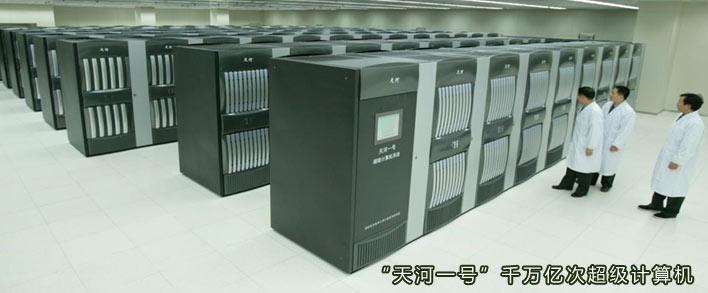 China’s National Supercomputer Centre announced that the prototype for its exascale supercomputer will be completed later this year, ahead of its initial date in 2018. The successful performance and commercialization of the computer is presumed to drastically improve existing 3D printing or additive manufacturing methods.
China’s National Supercomputer Centre announced that the prototype for its exascale supercomputer will be completed later this year, ahead of its initial date in 2018. The successful performance and commercialization of the computer is presumed to drastically improve existing 3D printing or additive manufacturing methods.
Over the past few years, the Chinese government and companies in the private sector have been increasingly focused on the development of supercomputers. The Tianhe supercomputer series which feature Tianhe-1 and Tianhe-2, still remains as the most powerful supercomputer series, below the Sunway TaihuLight which was released in mid-2016.
Zhang Ting, a computer engineer based in the National Supercomputing Center of Tianjin located at the National Defense Science and Technology University, revealed earlier this month that in 2020, three years after the completion of the prototype, the exascale computer will be used to its full potential, running a wide range of applications, networks and platforms.
“A complete computing system of the exascale supercomputer and its applications can only be expected in 2020, and will be 200 times more powerful than the country’s first petaflop computer Tianhe-1, recognized as the world’s fastest in 2010,” said Ting.
Still, the general population including technology communities struggle to understand the potential the exascale computing project holds. More importantly, the impact of the launch of an exascale computer on the global technology ecosystem and data-based operations.
Exascale computing is based on a rate of 1,000,000,000,000,000,000 calculations / second – or a quintillion (a billion billion) calculations per second. An exascale computer’s rapid rate of data processing is presumed to optimize any operations or initiatives which include analysis or evaluation of massive volumes of information. Technologies like artificial intelligence (AI) or 3D printing that consider an immense amount of data points can be optimized with exascale computing.
In fact, the developers of the exascale computer specifically emphasized its capability of simulating and operating additive manufacturing processes. The Exascale Computing Project (ECP) development team stated:
“At a quintillion calculations each second, exascale supercomputers will more realistically simulate the processes involved in precision medicine, regional climate, additive manufacturing, the conversion of plants to biofuels, the relationship between energy and water use, the unseen physics in materials discovery and design, the fundamental forces of the universe, and much more.”
Speeds or efficiency of 3D printing or additive manufacturing methods mostly rely on hardware such as 3D printers. 3D scanners, and imaging and editing technologies can improve the designing and prototyping processes but the performance of a computer hardly affects the final phase of additive manufacturing.
However, phases of designing, development and prototyping have proven to be most time consuming and labor heavy for manufacturers because of the accuracy and precision required to produce error-free end products.
Through the usage of an exascale computing-based application, manufacturers will be able to use additive manufacturing technologies to better simulate end products and significantly optimize processes before the last stage of manufacturing.
Stephen Lee, ECP Deputy Director, firmly believes the exascale computer will unlock opportunities for emerging technologies like 3D printing technology to enter a new era of computing and high-performance.
“Computational power is a vitally important tool that enables scientific discovery and assists us in finding solutions to some of our most difficult problems. The quest to achieve capable exascale computing is a quintessential technological challenge that will serve to enable a new generation of insights into such discoveries and solutions,” said Lee.
Discuss in the Exascale Supercomputer forum at 3DPB.com.
[Image Sources: People’s Daily, NDSTU]
Subscribe to Our Email Newsletter
Stay up-to-date on all the latest news from the 3D printing industry and receive information and offers from third party vendors.
Print Services
Upload your 3D Models and get them printed quickly and efficiently.
You May Also Like
Consolidation in AM: How 2025 Is Shaping the Industry’s New Normal
The first half of 2025 has been marked by a clear shift in the additive manufacturing (AM) industry. Companies are no longer just focused on developing new tech by themselves....
Etsy Design Rule Change Reduces Selection of 3D Printed Goods
Online marketplace Etsy has implemented a rule change requiring all 3D printed goods on the site to be original designs. The update to the site’s Creativity Standards states, ¨Items produced using...
U.S. Congress Calls Out 3D Printing in Proposal for Commercial Reserve Manufacturing Network
Last week, the U.S. House of Representatives’ Appropriations Committee moved the FY 2026 defense bill forward to the House floor. Included in the legislation is a $131 million proposal for...
Transforming From Tourist to Native: Duro CEO Michael Corr Explains Why the Company Rebuilt its PLM Software on AI
In these early innings of the AI boom, many market analysts have expressed concern that AI spend has gotten too far ahead of the technology’s proven ability to deliver significant...


































